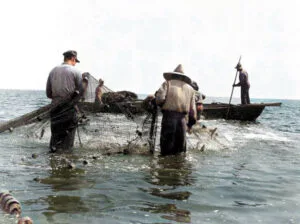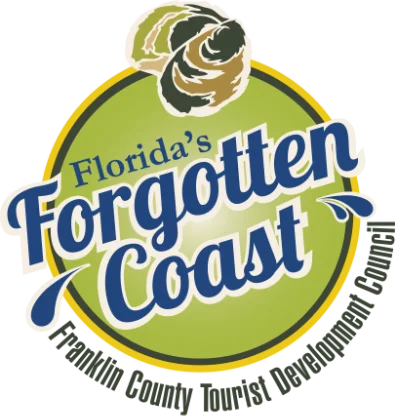You are here: Home > Franklin County Maritime Heritage Museum >
Franklin County’s Early Seafood Industry
Franklin County’s seafood industry is as important today as it was more than 175 years ago. It is the seafood industry that has most significantly shaped the culture and maritime heritage of the area and it is the seafood industry that anchors a growing nature-based tourism industry throughout the region.
Oysters
 Oysters were Apalachicola’s first seafood industry. Oysters were sold locally as early as 1836, harvested much the same as they are today with scissor-shaped tongs hoisted aboard shallow-draft skiffs. By 1850, oysters had begun to be packed in barrels and shipped aboard steamers headed north or to other neighboring states.
Oysters were Apalachicola’s first seafood industry. Oysters were sold locally as early as 1836, harvested much the same as they are today with scissor-shaped tongs hoisted aboard shallow-draft skiffs. By 1850, oysters had begun to be packed in barrels and shipped aboard steamers headed north or to other neighboring states.
Sustained commercial seafood success began in the late 1880s when German immigrant Herman Ruge, along with his two sons John G. and George H. Ruge opened the Ruge Brothers Canning company in 1885. Through the technique of pastereurization, the Ruge’s became Florida’s first successful commercial seafood packers. John Ruge is also credited as an early advocate of planting oysters shells near existing oyster “beds” to provide places for spat to settle during spawning. Other prominent oyster industry pioneers included Joseph Messina, an early seafood dealer who took over the Bay City Packing Company in 1896 and packed oysters and shrimp under the trademark “Pearl Brand.” By 1915, the Bay City Packing Company shipped canned shrimp to northern markets.
There were several large and small seafood dealers in Franklin County by the 20th century. By 1915, fishing and oystering ranked as the area’s second most important industry behind lumber and Franklin County led the state in oyster production.

With the completion of the John Gorrie Bridge in 1935 Eastpoint became an inexpensive site for the seafood industry to locate along the shore. The population of Eastpoint grew from 65 people in 1939 to 800 people just 15 years later.
However, expansion of the seafood industry in Eastpoint struggled due to the lack of deep water along the waterfront. Early Eastpoint seafood processing houses were typically built out over the water and at low tide the houses were high and dry. Boats could reach the processing houses to unload only on a high tide. After the end of the Second World War state and local officials petitioned the U.S Army Corps of Engineers to dredge the Eastpoint channel. Federal funding was received and in 1954, the channel was dredged. The new channel had an immediate economic impact on Eastpoint. Boats could unload their catch at the processing houses at any time of the day, and larger boats could reach the Eastpoint waterfront, resulting in larger catches being landed. In addition to smaller oyster boats, shrimp boats up to 56 feet long, drawing 6 feet of water regularly used the Eastpoint channel. Among the early vessels that used the channel were the Jennifer Mitch, Laura J, Sonya Nita, Captain Ed, Little Lady, Captain Jordan, and Captain’s Lady. A permanent breakwater was built just offshore in 1984 to help stabilize the channel for continued commercial fishing boat traffic.
Shrimp
 Shrimp were plentiful in the bay area but were not commercially successful until around 1900 when haul seines was introduced. By the mid 1910s, several local seafood companies were in operation along the Apalachicola riverfront, including the Ruge Brothers Canning Company, Bay City Packing Company, Apalachicola Packing Company, Rice Brothers Packing Company and the Apalachicola Fish and Oyster Packing Company. By 1915, multiple canneries were shipping canned seafood, including shrimp, to northern markets.
Shrimp were plentiful in the bay area but were not commercially successful until around 1900 when haul seines was introduced. By the mid 1910s, several local seafood companies were in operation along the Apalachicola riverfront, including the Ruge Brothers Canning Company, Bay City Packing Company, Apalachicola Packing Company, Rice Brothers Packing Company and the Apalachicola Fish and Oyster Packing Company. By 1915, multiple canneries were shipping canned seafood, including shrimp, to northern markets.
Other developments such as the trawl enabled the shrimping industry to thrive and it soon matched the successful oyster industry. Then, as now, seafood industry workers were resourceful. When shrimping or oystering was slack, boat owners often switched to catching blue crab or other commercially lucrative product, including finfish such as mullet or sturgeon.
Crab
One of the earliest commercial fisheries for blue crabs in the Gulf of Mexico reportedly existed in Franklin County. Historical accounts reference William H. Boyington and his son, Jesse, who, in the 1880s, fished trotlines in Doyle and Whiskey George and traded their crabs for farm products and staples.
 According to marine fisheries research, Eastpoint seafood dealer Arthur Tucker is considered a pioneer in the crabmeat processing industry as he is credited as having the state’s earliest-reported crabmeat picking and shipping operation. Tucker, who owned Eastpoint’s A.L. Tucker’s Wholesale Seafood Company, began his largescale crabmeat picking operation in 1930 after researching the success of other processors in Alabama in the late 1920s. Tucker packed crab meat in pint jars and shipped it to New York by rail.
According to marine fisheries research, Eastpoint seafood dealer Arthur Tucker is considered a pioneer in the crabmeat processing industry as he is credited as having the state’s earliest-reported crabmeat picking and shipping operation. Tucker, who owned Eastpoint’s A.L. Tucker’s Wholesale Seafood Company, began his largescale crabmeat picking operation in 1930 after researching the success of other processors in Alabama in the late 1920s. Tucker packed crab meat in pint jars and shipped it to New York by rail.
Prior to 1930, the Florida blue crab fishery supplied a local, “barter-type” market where all the crabmeat and crabmeat products were consumed locally. Franklin County’s blue crab fishery, like other seafood products, did not flourish until the advent of railroads to the area. Prior to rail travel, the fastest mode of transporting seafood was via steamboat upriver or sailing schooner across open water. Either way, it was a trip that often required several days.
Early area crab fishermen used trotlines (submerged lines baited at repetitive intervals) to catch crabs. Crab fishermen fishing trotlines could harvest as many as 2,500 pounds per day on good days. Over the years, various types of gear have been employed to capture blue crabs, but in recent years the buoyed, wire-mesh trap has superseded all other gear types.
Today, an active blue crab industry exists in Apalachicola Bay. Marine fisheries statistics show that Franklin County produces nearly 10 percent of the hard-shell blue crabs landed in Florida. Blue crabs, both hard-shell and softshell or “peelers” are typically harvested inshore in the estuary.
Finfish

Photo provided by Bill Price & the Florida Department of State Photo Archive
Franklin County’s commercial finfish and fish-packing industry grew alongside commercially-successful oyster, shrimp and bluecrab industries in the late 1800s. Most notable among early seafood entrepreneurers was Greek emigrant A.J. Murat, a Confederate veteran who served in the Civil War and returned to Apalachicola where he employed 80 fishermen and exported barrels of of pickled mullet and fresh fish packed in ice. According to a Savannah newspaper account at the time, Murat engaged in the sea-food business and built up an extensive trade, shipping large quantities of salt fish and roe to different sections of the South and West.
“The fish are caught in seines, generally of the length of 750 yards, and sometime as many as 55 barrels of fat, shining mullet are dipped and landed at one haul. The seines are narrow, but very long, and being extended full length, are weighted at the lower side and buoyed with large pieces of cork at the upper side to hold it vertically, when it is slowly drawn towards the smooth sandy beach and halted near the shore. Then the fish are landed with dip nets by the fishermen. Delivered at the packing houses, they are beheaded and cleaned and placed, carefully packed, under the supervision of a foreman, who sees that the brine is sweet and weight full, and they are then headed up, the brine poured in and plugs inserted, when they are labeled and shipped. Murat’s packer shipped over $17,000 worth of fish products this season. The heads and entrails go to the fertilizer works, and are sold far and near at $35 per ton, making an excellent fertilizer.”
~The Morning News, Savannah, Georgia, Friday, January 11, 1884
In addition to being a successful seafood businessman, A.J Murat had some impressive family connections. He was the great-great-grandson of Marshal Murat, Napoleon’s famous general, who afterward became King of Naples. He was the great-great-nephew of four kings—Napoleon, Louis of Holland, Joseph, King of Spain, and Jerome of Westphalia. He was a third cousin of Louis Napoleon and great-great-grandson of Napoleon’s mother, who died in 1836, the year he was born.
Today, the commercial fishing industry remains an important part of Franklin County’s economy. According to a 2021 report from the Florida Department of Agriculture, the most recently available data, Florida ranks 5th in the United States for commercial seafood production with $262 million in dockside value. The commercial fishing industry in Franklin County is all-encompassing, supporting jobs in marinas, restaurants, marine equipment, retail stores and many other industries.

